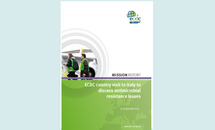ECDC country visit to Italy to discuss antimicrobial resistance issues
An ECDC team conducted visits and meetings to Italy on 9-13 January 2017 - to specifically discuss and assess the situation in the country regarding prevention and control of AMR through prudent use of antibiotics and infection control.
Observations from this ECDC country visit confirm that the AMR situation in Italian hospitals and regions poses a major public health threat to the country. If the current trends of carbapenem resistance and colistin resistance in gram-negative bacteria such as Klebsiella pneumoniae and A. baumannii are not reversed, key medical interventions will be compromised in the near future.
Executive summary
Rationale and purpose of the country visit
A Council Recommendation dated 15 November 2001 on the prudent use of antimicrobial agents in human medicine (2002/77/EC) outlines the threat that AMR poses to human health and advocates a range of actions to be taken for its prevention and control. Council Conclusions on antimicrobial resistance (AMR) dated 10 June 2008 reiterate this call for action.
To assist Member States in implementing the Council Recommendation, ECDC has developed a process for country visits, which are carried out at the invitation of national authorities. These visits are designed to specifically discuss and assess the situation in the country regarding prevention and control of AMR through prudent use of antibiotics and infection control. The visits also help document how Member States have approached implementation of the Council Recommendation and deployed national resources in order to support the European Commission in evaluating implementation.
The main output of the visit is a report from ECDC provided to the national authority. To help ECDC ensure the consistency of the visits and follow up on progress, an assessment tool has been developed. The assessment tool includes ten topics which are regarded as the core areas for successful prevention and control of AMR, based on Council Recommendation 2002/77/EC and the Council Conclusions dated 10 June 2008. The assessment tool is used as a guide for discussions during the visit.
Conclusions
Observations from this ECDC country visit confirm that the AMR situation in Italian hospitals and regions poses a major public health threat to the country. The levels of carbapenem-resistant Enterobacteriaceae (CRE) and Acinetobacter baumannii have now reached hyper-endemic levels and, together with meticillin-resistant Staphylococcus aureus (MRSA), this situation causes Italy to be one of the Member States with the highest level of resistance in Europe.
During conversations in Italy, ECDC often gained the impression that these high levels of AMR appear to be accepted by stakeholders throughout the healthcare system, as if they were an unavoidable state of affairs.
The factors that contribute negatively to this situation seem to be:
- Little sense of urgency about the current AMR situation from most stakeholders and a tendency by many stakeholders to avoid taking charge of the problem;
- Lack of institutional support at national, regional and local level;
- Lack of professional leadership at each level;
- Lack of accountability at each level;
- Lack of coordination of the activities between and within levels.
If the current trends of carbapenem resistance and colistin resistance in gram-negative bacteria such as Klebsiella pneumoniae and A. baumannii are not reversed, key medical interventions will be compromised in the near future. Untreatable infections following organ transplantation, intensive care or major surgical interventions are now a significant possibility in many Italian hospitals.
ECDC believes that the first step towards halting and reversing the current multidrug-resistant microorganism (MDRO) situation is to strengthen the current systems and introduce appropriate measures to reduce unnecessary antibiotic use (in communities and hospitals) while improving infection control.
Such corrective actions need to be taken at the following levels: national, regional and local (hospital).
There needs to be a greater sense of urgency regarding the current AMR situation at all levels and among all stakeholders in the country. This also includes the need to establish clear definitions of the responsibility of each stakeholder. During all the meetings held as part of the visit, ECDC were impressed by the enthusiasm and dedication of the many professionals who can contribute to this effort. These people represent an asset to the country and an opportunity to address or even reverse the current AMR situation.
AMR is a national and cross-regional challenge, especially because the movement of patients (and resistant bacteria) is not restricted by regional borders. Therefore there is a significant risk that, with a regional framework such as that in Italy, it may not be possible to achieve cohesive and standardised action nationwide when dealing with a threat such as AMR. For this reason, a comprehensive coordinated response is required that ensures central coordination, supervision and auditing of the progress being made in the regions, especially those with higher prevalence.
It is vital that the examples of good practice that we observed during our visit in some regions/hospitals across the country are extended to all the other areas, especially those with the highest levels of AMR. ECDC believes that this will not be possible without strong and coordinated activities at central level, which will result in concrete actions at regional and local level.
Download





